Content of the article
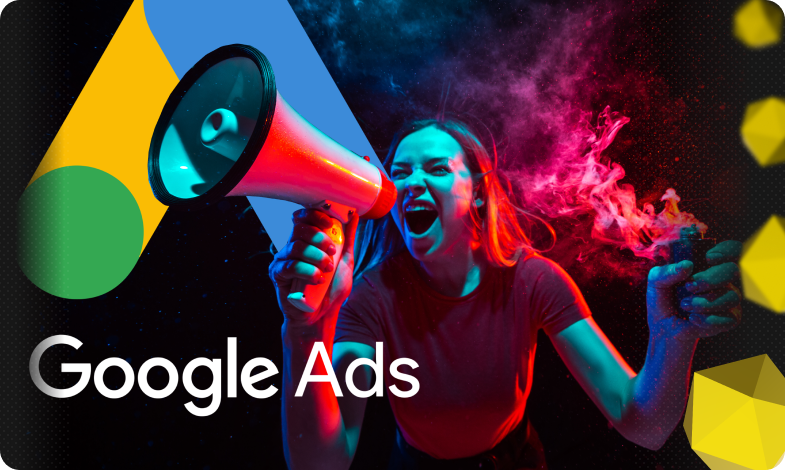
Google Adwords (Ads) advertising service is a system for setting up and placing contextual advertising in the search engine, on Google sites and on partner resources in the contextual-media network. And it is also the world’s first service, in terms of the number of advertisers and consumers of contextual advertising (search, media, product). It is competing with others, in China, for example – Baidu. In all other countries it is among the leaders. Therefore, advertising in Google has the greatest reach.
Advertising in Google is very diverse in type and form. Now through the Adwords interface can be set up and advertising even on the popular video service YouTube. It is possible to customize various animated, flash, etc. ads.
But in this group of articles will be written about setting up contextual advertising in the Google search engine.
Account registration
In order to perform any work with keyword collection or advertising you need to create and activate an Adwords account. To do this, you first need to create a Google profile – register your email and link your phone number or a spare email to it.
To create an advertising cabinet you need to create a blank ad and specify payment details. It is important that the method of payment specified during registration can no longer be changed, and if the payer was specified as a private person, then change it then to a legal entity is no longer possible – you need to change the account. Therefore, when filling in the data you should never make a mistake.
After you have logged in the mail, you need to specify your website in Google Ads.
On the next page, fill in all the necessary data – you can fill them in with any data, we will delete them later anyway:
- Cost per click
- Regional targeting
- Keywords
- Ad text
And click “Save and continue”.
On the next page you fill in all the data on payment and payer, currency and country of the account. But be extremely careful – all the entered data can no longer be changed.
Specifying a credit card will allow the service to withdraw money from your card, so at the initial stages it is better to make payments by “Prepayment”.
When filling in the data on the amount of payment, you will be given an invoice and will be offered to save it, but you can not pay for it – it does not oblige you to anything.
After all this, check the box next to the line that you accept the License Agreement and click “Save”. If everything is filled out correctly, then you will go to the welcome window of the advertising system. If there are incorrectly specified data, then the line with erroneous information will be highlighted in red, you need to complete the information and save the data again.
Once you are on the welcome page, click the blue button at the bottom – “Go to your account”, and the main page of the Google advertising cabinet will open.
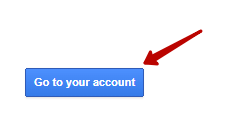
Collecting semantics for Google Ads
The first thing that starts with setting up an advertising campaign is the collection of semantic core. A special service was developed especially for this purpose – KeyWords Planner. To do this, go to the menu “Tools” (above, the button in the form of a wrench) and in the first column “Planning” select the item “KeyWords Planner”.
Wait for the service to load and select the first option – “Find keywords”.
In the window that appears, enter the page to which you want to run ads, or a few basic keywords that describe your service, comma separated. It is better to use keys, because the URL analyzer works on the text on the page and can take the wrong phrases. It is allowed to enter a maximum of 3 phrases, but it is enough for the service to pick up your keys for advertising. Next, click “Show results”.
We need to immediately save the results in order to conduct all further work in MS Excel. To do this at the top of the screen there is a button “Download keyword variants”, click it and wait until the service generates a report file and request permission to save the file on your computer. You save this file and open it. If you will not search several groups of keys, you do not need the Key Phrase Planner.
Features of KeywordsPlanner
The purpose of KeyWordsPlanner is to collect keywords for contextual advertising. When you set keywords in Adwords, the result is not only words that consist of the entered phrases, but also words that are close in meaning and synonymous with them. For example, a query – “buy a car” and its synonym “buy a car”. That is, when uploading from Google KeyWordsPlanner you will have a list of phrases synonyms with their occurrence.
Example: the key “buy a car”. Adwords keys:
- Buy car
- Buy car
- Car price
- Etc.
Key phrase search
Open the saved file and perform initial formatting of the file:
- Delete all columns except “Keyword”
- Add the “Minus words” column.
Start searching for the keys we need. We do not change the keys that are suitable for us, and highlight the keys that are not suitable in red. From them in the column “Minus words” add the word that makes the phrase not suitable. Carefully when collecting minus-words – do not add there words that may be in the target keys.
This way you need to review all the keywords.
Example:
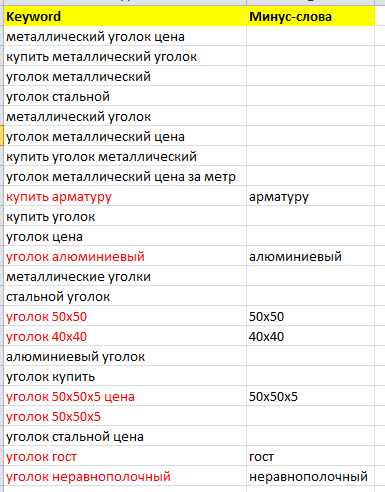
Next, by setting the filter to the topmost rows, we sort all the target keys.


Copy all keywords to the clipboard. After that, you open a special ad fill template file via GoogleAdwordsEditor. Next, you paste all the keys into the “Ad Group” column, on the “Groups+words” tab.
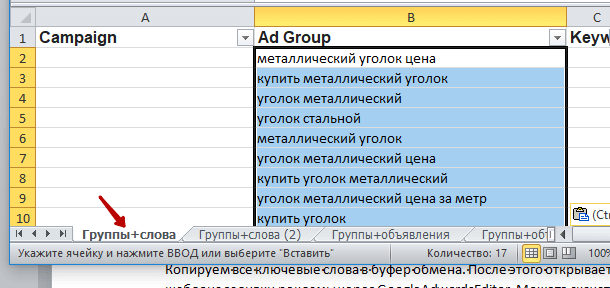
In the “Campaign” column, write the name of the ad campaign and stretch across all rows in the “Ad Group” column.
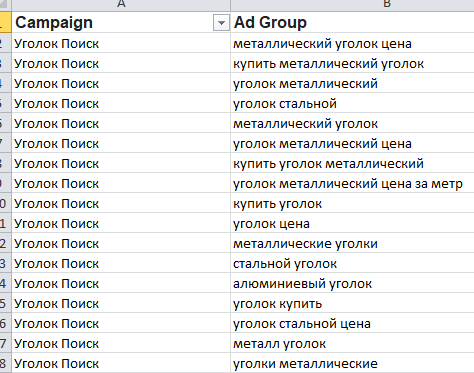
Then copy these 2 columns with values to all tabs except “BS”.
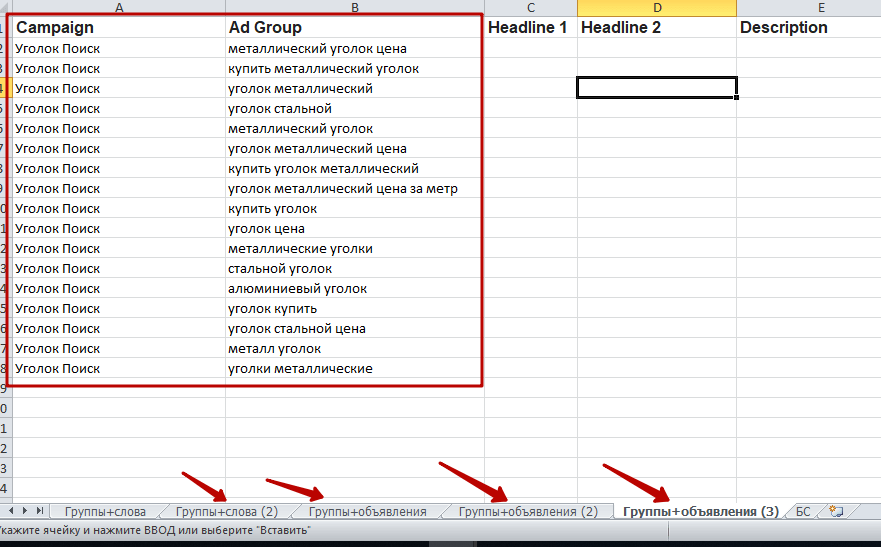
Adding match types to keys
In order for ads to be shown on the most relevant keys and to be able to adjust the cost per click, it is necessary to add match types to key phrases. Most often we use exact and broad match. The first is determined by the presence of square brackets, and the second – the presence of pluses in front of all words in the key phrase. You can do it manually, just going through all the keys and prescribing by yourself.
You can use a ready-made service. For example, http://tools.yaroshenko.by/matchtypes.php. Add the keys with a “broad match” to the first tab “Groups+words”.
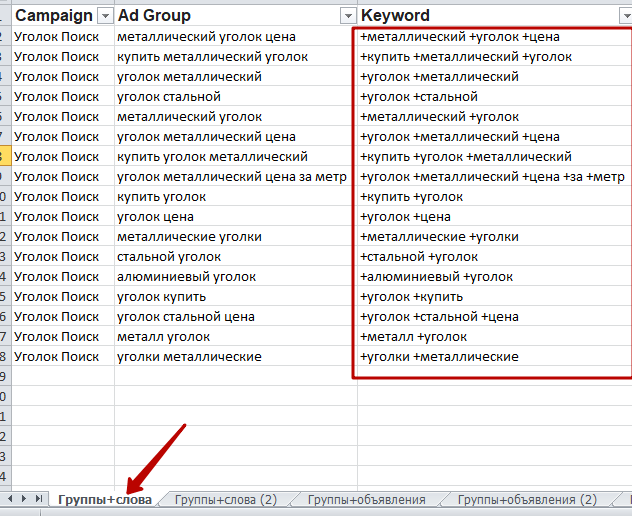
We add the keys in “exact match” to the second tab “Groups+Words (2)”.
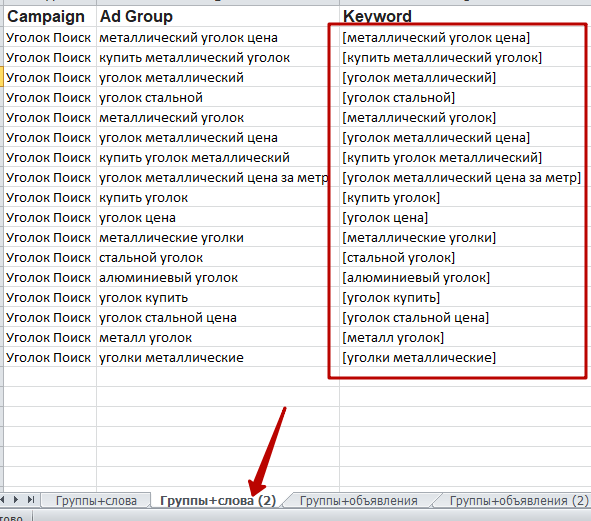
Writing ads for Google Adwords
Ad text writing is a very important step in creating ad campaigns. Its CTR depends on the quality of text ad writing. Therefore, when writing texts you need to analyze your competitors very carefully and compose your own Unique Selling Proposition (USP). In the texts of competitors’ ads you need to highlight all their key phrases, compare them with your own and choose the ones that should hook the client the most.
GoogleAdwords has a built-in functionality to analyze the effectiveness, so you can try to combine different benefits and the system itself will select the best ad.
Basic rules for writing ad texts:
- Should start with capital letters
- Do not use spacing
- Capitalization is applied according to spelling rules
- Spelling mistakes in words are unacceptable
- Punctuation should not be abused
- It is forbidden to use trademarks and registered brand names without proper authorization of the right holder.
- Text sizes: Heading 1 – 33 characters (here you can specify a key word or phrase), Heading 2 – 30 characters (indicates additional information – about promotions, discounts), Descriptions – 80 characters.
Components of Google Ads (basic)

- Heading 1
- Heading 2
- Description
- Displayed URL
We will look at populating all of these components.
Writing Headline 1
There are various techniques for writing the first headline for ads, but the most tried and trusted remains the direct or almost direct insertion of the key into the headline. This means that if you have the key “buy metal angle”, it can be inserted into the first headline without modification. If you get unreadable keys, such as “metal angle price”, then it can be slightly modified to make it readable, for example, so – “Metal angle price” or “Metal angle prices”, etc.
This headline can be applied in all 3 versions of the ad. Since the key does not contain the UTP itself, and the application of a direct key increases the clickability of the ad, we simply copy Heading 1 among all variants.
Example:
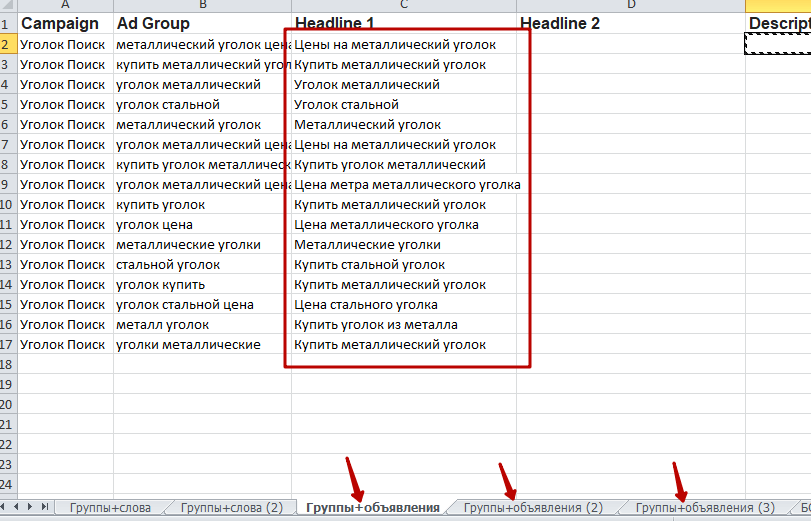
Writing headline 2
Since Google Adwords always displays a second headline, you can put your benefits and advantages in it. You can identify your top 3 benefits and write 3 different texts and categorize them. You should put as many benefits as possible in this headline, as it is displayed in a large font and at the top of the ad.
Example:
The first group of ads Headline 2 would be – Delivery in 24 hours. In stock.
The second – Low prices – from 50 UAH/m.p.
Third – We work 24/7. Own fleet.
Bring the headlines in the table, each in its own tab in the column “Headline 2”
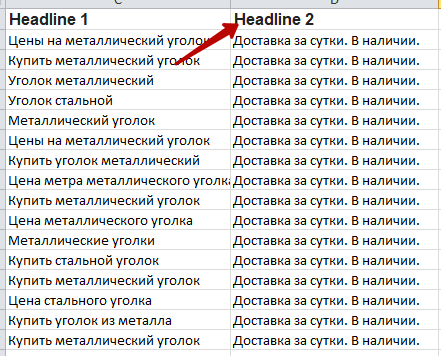
Writing the text of the “Description”
In the description you should add, if possible, all the other benefits that are not mentioned in the headlines. If you don’t have enough benefits, you can take some implicit ones or analyze your competitors’ ads and choose from their benefits what suits you.
In this case, you can assemble a “Description” from the benefits listed in Heading 2 of the other ads.
Text “Description” for the first ad – Low prices – from 50 UAH/m.p.. We work 24/7. Its own fleet. 10 warehouses in Kiev.
For the second – Delivery in a day. Goods in stock. We work 24/7. Own fleet. 10 warehouses.
For the third – Delivery in a day. Goods in stock. Low prices – from 50 UAH/m.p. 10 warehouses.
Enter all ads in the table in the column “Description”, each in its own tab.
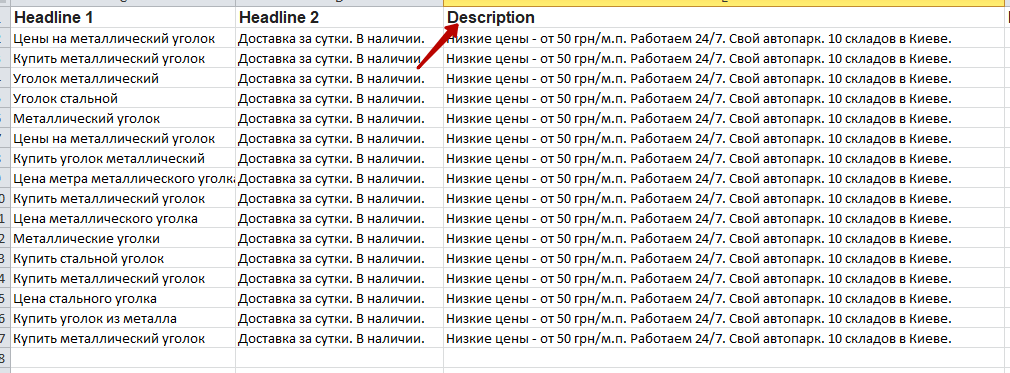
Writing the displayed URL and link
The Google Adwords advertising platform offers extensions to the appearance of the ad. One of them is the Display URL. It consists of 2 parts of 15 characters each. In them, it is allowed to write text in Cyrillic or Latin characters. You can also use other special characters, spaces are allowed. But their use may not look attractive and it is better to use underscores or hyphens instead of spaces.
When writing a displayed URL is desirable to use keywords. This will once again show in the advertisement that a person will get exactly where you need. Let’s take as a basis for the focus query “metal corner”, then you can write “Metal Corner”. We add to the table, each in its own cell, the word “Corner” – in “Path 1”, and the word “Metal” in “Path 2” and copy it into each ad.
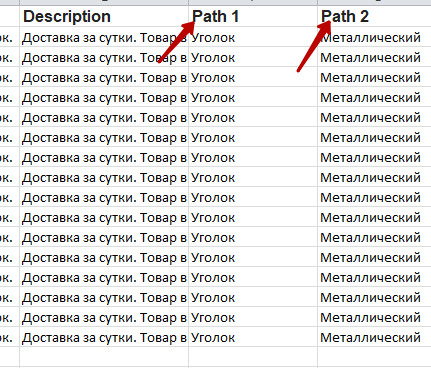
Next, in the “Final URL” column, we insert the address of the page to which a person should be directed when clicking on the ad. For example, https://27.ua/shop/ugolok-metallicheskiy/. And copy it into all ads.
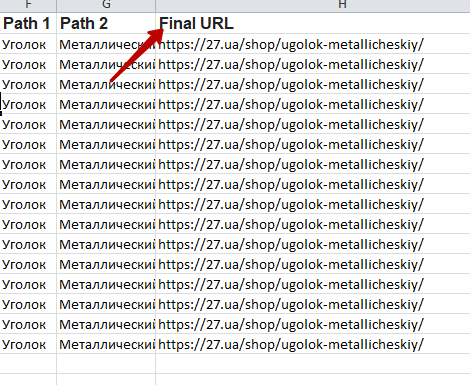
Quick Links for Google Adwords Campaigns
Description of BC
This is a block displayed below the text of the ad, consisting of four words or word combinations with links to pages of the advertised site or any other. Visually, quick links expand the ad and make it larger and more noticeable, and as a consequence – clickable. Quick links can be less than 4, but not more – it is at the choice of the advertiser.
Selected quick links based on what may still be interesting to a potential customer. These could be related products or destinations, for example. In an ad for laptops, you can add accessories. Often make links to service pages, such as: “About Us”, “Shipping” and payment, etc.
Syntax for writing quick links
For implementation through import files, specific headers for quicklink columns have been developed. Quick links consist of:
- аnchor (Link Text column) – text that is displayed below the ad block. When clicking on which, a person goes to the landing page. The size of the link is up to 25 characters.
- first description line (column “Description Line 1”) – text that is displayed under the quick link in special cases. The size is up to 35 characters.
- second description line (Description Line 2 column) – text that appears below the first description line of the quick link in special cases. The size is no more than 35 characters.
- page link (column “Final URL”) – a link to the page that should be opened when clicking on the quick link.
Open the “BS” tab in the file and specify all the components of quick links. The number of links is not limited, but they will be displayed no more than 4 pieces. If more quick links are added, then either the first ones added or randomly will be displayed.

To summarize
Google AdWords provides all users with opportunities and tools to run effective advertising campaigns, customize the payment principle, conduct testing, change key metrics and work directly with the target audience.
In this article, we’ve covered everything you need to do to initially load an ad campaign in Google Adwords. Read about add-ons in Adwords ad campaigns and the process of template uploading itself in the following articles.

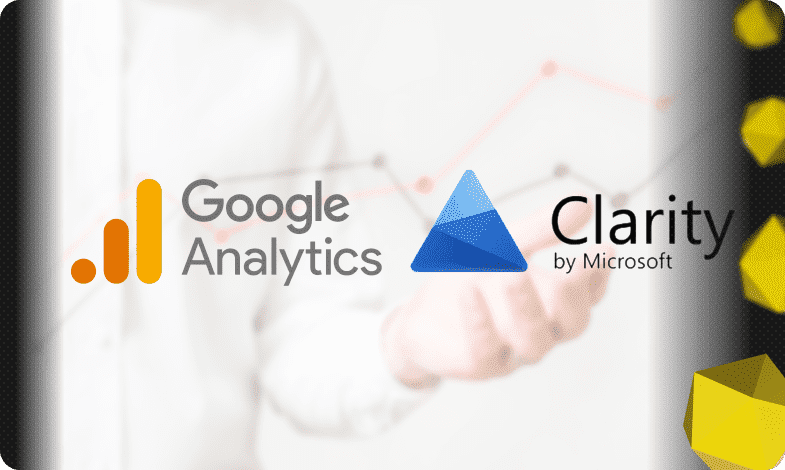




 29/09/2023
29/09/2023  3307
3307



